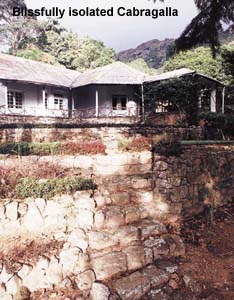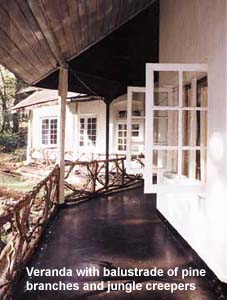 |
 29th March 1998 |
Front Page| |
The Plantation HomeRustic charm amidst roaming elephantsSecluded in hillside tea plantations are bungalows recalling part of Sri Lanka's recent past. Royston Ellis and photographer Gemunu Amarasinghe set out to discover some of them in this fortnightly series.... Poonagalla Lower Division tea estate has been in the news recently as elephants have made it their home. While some estate workers have been killed by the wild elephants, the assistant superintendent who lives in the bungalow on the plantation, thrills at the chance to observe elephants at close quarters. He need only look out of the bungalow's back window to see a tusker pondering under a breadfruit tree 10 feet from the house. Evidence of elephants' marauderings are everywhere in the bungalow's
garden. Bark is scraped off the breadfruit tree where they contentedly
rub themselves against the trunk, and footprints show where The Poonagalla Lower Division bungalow is itself part of that tradition. In 1895 it was known as the Cabragalla Bungalow and the Cabragalla Estate was one of four which made up the Poonagalla plantation owned by Sir George Pilkington. The estates were managed by James Bisset, a contemporary of James Taylor, that pioneer grower of tea, who hailed from the same Scottish village as Taylor. James Bisset would have lived in the predecessor of the bungalow that is the residence today of the Assistant Superintendent of the Poonagalla Lower Division. The Superintendent of Poonagalla, Mr. Vije Johnpillai, has discovered in the plantation office a Visiting Agent's (VA) report, dated 1895, which mentions Cabragalla. In careful, if eccentric copperplate, the VA observes that the bungalow at Cabragalla: "commands one of the finest views ever to be seen anywhere over a large stretch of low country with the sea in the background." Then he adds: "Poonagalla and Cabragalla together make a very valuable property and I consider the purchase of Poonagalla in many ways largely improves the value of..... Cabragalla.... it also largely settles the questions of outlet for all these properties." This was a reference to the then outlet being "by private cart
road to Koslanda and thence by government cart road to Haputale."
With Cabragalla absorbed into Poonagalla, access is now also If the bungalow looks older than the magnificent granite block mansion that is the main Poonagalla residence, it is perhaps because it has declined in importance. Hence its occupant is usually a sole bachelor with a couple of helpers and dogs for companions. The absence of a wife to fuss over the place is apparent. The image of the bungalow is not helped by the low, enveloping roof, supported by spindly columns where it shades the veranda, which creates a somewhat ramshackle appearance. However, the present occupant has added rustic charm to the veranda with a balustrade of pine branches and jungle creepers. The veranda embraces the sprawl of the bungalow and has a canopied landing, reached by steps from the garden, as its entrance. This is an introduction to the visitors' hall, a bright but basically furnished lounge since this is a working planter's bungalow rather than a stylish one. An open arch leads to the bungalow's best feature, the dining room. This has a fine oval table matched by smart chairs and other estate period furniture. The master bedroom, complete with study and attached bathroom, is on the right. The doors to the left lead to two linked guest rooms, sharing a bathroom between them. Two strutted wooden beds of entirely different design, pretend they are twins in one of the rooms. In the bathroom, the wash basin is Royal Doulton with a useful inset ledge not found in modern bathroom sinks. A gallery winds around the back of the bungalow to a kitchen and store room. The entrance to the store is so low and the walls so thick, it is probably part of the original bungalow that was there in 1895. Outside it, a lone bull elephant trumpets at night, perhaps instinctively knowing that before tea was grown and the Cabragalla bungalow was built there, this area was the home of his ancestors. |
||
|
Front Page| News/Comment| Editorial/Opinion| Business| Sports | Mirror Magazine |
||
|
Please send your comments and suggestions on this web site to |
||


 they
come to slurp water from the pond. The tea plantation is some 4,000 feet
above sea level but experts say planters should not be surprised at this
hill-climbing invasion by elephants since they are actually returning to
their traditional homeland. It was because the land was taken over, first
for coffee and then tea, in the last century that elephants living there
were driven down to the dry zone jungles for survival.
they
come to slurp water from the pond. The tea plantation is some 4,000 feet
above sea level but experts say planters should not be surprised at this
hill-climbing invasion by elephants since they are actually returning to
their traditional homeland. It was because the land was taken over, first
for coffee and then tea, in the last century that elephants living there
were driven down to the dry zone jungles for survival. possible
by road from Bandarawela and the estate's tea is processed at the CTC factory
at Poonagalla. However, the Cabragalla bungalow is still blissfully isolated,
apart from the nocturnal visits by elephants.
possible
by road from Bandarawela and the estate's tea is processed at the CTC factory
at Poonagalla. However, the Cabragalla bungalow is still blissfully isolated,
apart from the nocturnal visits by elephants.